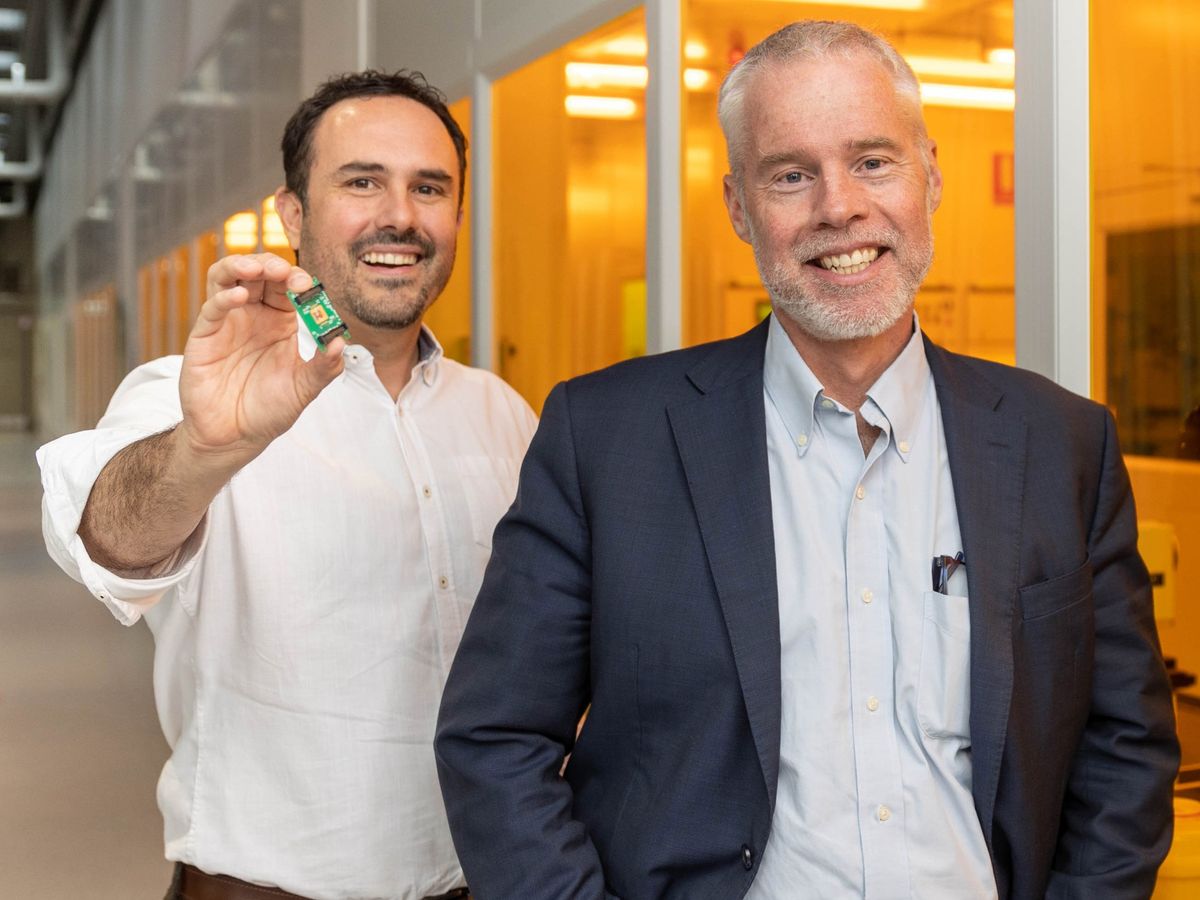Researchers at the University of Sydney have combined a photonic filter and modulator on a single chip in a way that allows them to precisely detect signals across a wide band of radiofrequency (RF) spectrum. The work brings photonic chips one step closer to one day potentially replacing bulkier and more complex electronic RF chips in fiber optic networks.
The Sydney team exploited stimulated Brillouin scattering, a technique which involves converting electrical fields into pressure waves in certain insulators, such as optical fibers. In 2011, the researchers reported that Brillouin scattering held potential for high-resolution filtering, and developed new manufacturing techniques to combine a chalcogenide Brillouin waveguide on a silicon chip. In 2023, they managed to combine a photonic filter and modulator on the same type of chip. The combination gives the experimental chip a spectral resolution of 37 megahertz and a wider bandwidth than preceding chips, the team reported in a paper published 20 November in Nature Communications.
“The integration of the modulator with this active waveguide is the key breakthrough here,” says nanophotonics researcher David Marpaung of the University Twente in the Netherlands. Marpaung worked with the Sydney group a decade ago and now leads his own research group that is taking a different approach in the quest to achieve wide-band, high-resolution photonic radio sensitivity in a tiny package. Marpaung says that when someone reaches sub-10-MHz spectral resolution across a 100 gigahertz band, they will be able to replace bulkier electronic RF chips in the marketplace. Another advantage of such chips is that they would convert RF signals to optical signals for direct transmission through fiber optic networks. The winners of that race will be able to reach the huge market of telecoms providers and defense manufacturers who need radio receivers capable of reliably navigating complicated radio-frequency (RF) environments.
“Chalcogenide has a very strong Brillouin effect; it’s very good, but there is still a question of whether this is scalable…it’s still perceived as a lab material,” Marpaung says. The Sydney group had to figure out a new way to fit the chalcogenide waveguides in a 5-millimeter-square package into a standard manufactured silicon chip, which was no easy task. In 2017, the group figured out how to combine chalcogenide onto a silicon input/output ring, but it took until this year for anyone to manage the combination with a standard chip.
Photonic Chips Are a Global Effort
Other research groups are examining different materials that might also offer comparable performance. Lithium niobate, for example, has better modulator properties than silicon, and Marpaung has shown in work that is still undergoing peer review that lithium niobate could offer comparable high-resolution filtering via Brillouin scattering. Another group, led by Peter Rakich at Yale University showed last year that a silicon-only waveguide and chip combination could achieve 2.7 MHz filtering across a 6 GHz spectral band. That work did not integrate a modulator, but it hints at a potentially simpler manufacturing path that would involve fewer materials.
That said, the Sydney team’s approach may require better acoustic performance than silicon can provide. Researchers have known about the Brillouin effect for more than 100 years, but has attracted renewed interest in recent decades. In the past, researchers have used it to store the information in an optical pulse before retransmitting it, a trick that dodges the need to convert light into electricity and back again.
Of course, the dream of an integrated photonic chip has many moving parts. The Sydney researchers write that modulators made by others are improving fast in ways that will help their technology, too. Other advances in related tech may favor some of the other groups working on an integrated photonic chip. “If you solve the integration problem and the performance problem and practicality you will get market uptake,” Marpaung says.
- Photonic Chips Curb AI Training's Energy Appetite - IEEE Spectrum ›
- Novel Silicon Laser Sounds Like a Good Idea for Photonic ... ›
- Integrated Photonic Circuits Shrunk Down to the Smallest ... ›
- 6G Terahertz Devices Demand 3D Electronics ›
- Photonic Integrated Circuit Puts Exoplanet Hunter in a Cubesat - IEEE Spectrum ›
Lucas Laursen is the technology policy editor at IEEE Spectrum. He covers how emerging technologies are changing the balance of power between companies, governments, and individuals. The rest of the time, he worries about his own balance on a bicycle, skis or the side of a mountain.



